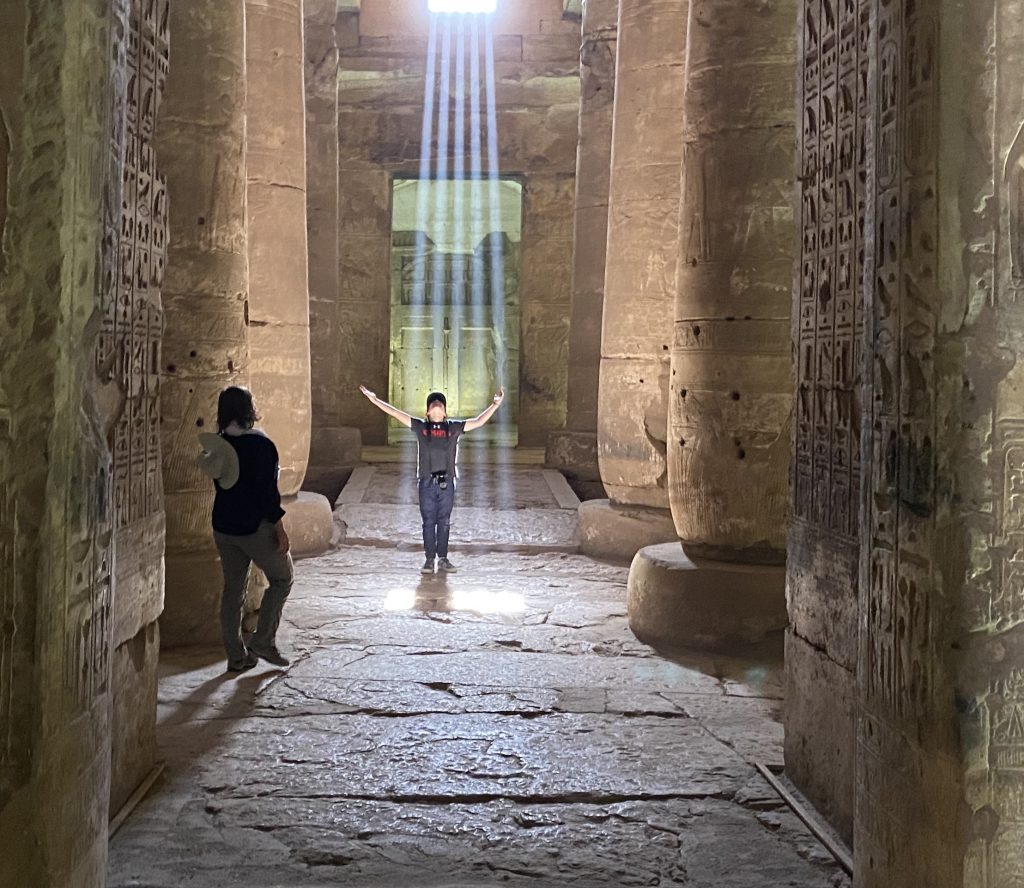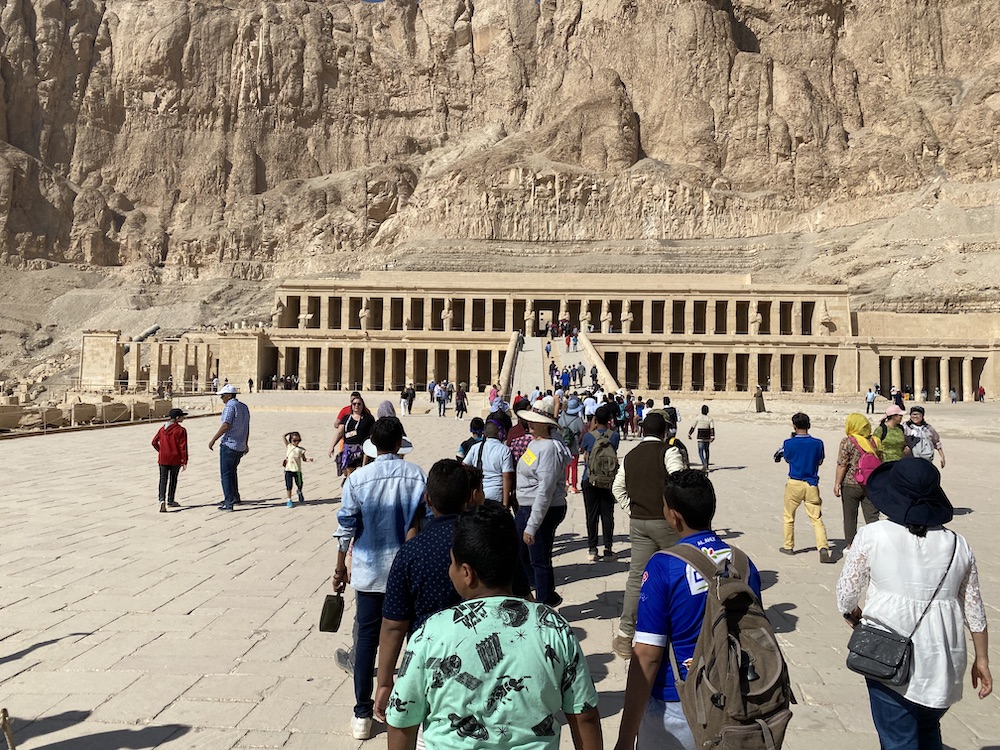
The train ride from Cairo south to Luxor was simultaneously agonizing and magical. Our sleeper car trundled back and forth, walls rattling like a washing machine on spin cycle, keeping me awake the entire eleven-hour ride. But when sun the rose, the countryside it revealed, as we followed the Nile, was a gorgeous mix of dark green fields, beige desert mountains and golden sunlight dappling brick farmhouses.
Cairo is a huge, pulsing heart, crammed with cars, smog, brightly lit signs and a dozen things all calling for your attention at once. The Egyptian countryside is like developing countries everywhere: Employing the same carts and donkeys from centuries past, with the odd bit of recent technology here and there. A cell tower, a gleaming chrome streetside water spigot, an armored car bristling with guns.
Security forces are ever-present in Egypt, but I’ll get to that in a bit. What sticks out as soon as you leave Cairo is that the Egyptian country is clearly poorer than it’s capital. Most roads are dirt, donkeys are used for transport as much as motorbikes, and there are innumerable empty shopfronts in the villages. But along the Nile, every square inch of land without a building or road has a crop. Alfalfa, corn,
There are no tractors here. Everything is done by hand, using scythes to cut the alfalfa, donkey-driven carts to move goods from farms to towns. Long and narrow fields stretch from the Nile, with the narrow side bordering the water. Groups of men and women move through them dressed in long gallibayas and sebleh, respectively, carrying hoes to till the fields.
Children seem to be everywhere, with the smallest four and five year-olds watched by ten and eleven year-olds. Moving through villages kids fill the streets, partly because public schools work in shifts, our guides told us. There are not enough schools for the country’s exploding population, so shift one attends from 7:00 a.m. to noon, and then after a lunch break teachers take the second group from 1:00 p.m. to 6:00 p.m. So, in effect, there’s always a group of kids going to school somewhere, and as you drive through villages in the south, slowed by pockmarked, dirt roads, swarms of children wave and shout, hoping to catch the eye of the rich tourists riding through town.
We got off the train in Luxor, a city of 500,000, to a jammed train station scene and a guide waiting for us on the platform. Lugging our bags, we threaded through the station as thousands of people flowed from multiple trains to the street and back again. Our guide pushed us into a waiting minivan, and away we went, crossing the Nile and into the desert to visit the Valley of the Kings.
While Cairo has the pyramids, Luxor is the star of the show, when it comes to antiquities. Known as Thebes in ancient times, it was the religious capital of Egypt, while Memphis and a rotating set of other cities in the north served as the political capitals. Here was the Temple of Karnak, a giant city-like collection of smaller temples, each one built by a king to deify themselves and to demonstrate their own closeness to the gods. But the state-religion was very much part of government, as the chief priest was appointed by the pharaoh and often held other top government jobs, like general or chief scribe. Karnak owned millions of acres and hundreds of thousands of cattle, geese, horses and everything else that could be ascribed to wealth for a barter-based society operating without currency, since money wasn’t really invented until Egypt had already been around for a few thousands years.
With all that wealth, Karnak and surrounding Thebes managed to get the best of everything. The best temples, the best art, the best statues – for millenia. Pharaohs, looking for a glorious place to be buried so they could enjoy the best afterlife, eventually settled on a desert valley just across from the Nile from Thebes. Religious lore said that this was where the sun god, Amun-Ra, rose in the morning on his way to the heavens, so kings dug deep holes into the ground to secure their mummified bodies, safe from thieves that might take the things they needed for their second life.
The modern-day result is a crazy, overwhelming bonanza of incredible art and history. The hieroglyphs covering tombs tell stories about feats of strength, personal grudges, wives and families. The artistry and architecture reaches out, demanding you recognize the person-ness of these kings and their servants. These are no mere names on a wall, they include royal faces, likely faces of artists and a plea from ages ago to remember that these people once lived here. “Remember us!” they cry, plying you with breathtaking art and ingenious construction methods that have endured the ages, despite their seeming lack of technology.

Remembrance, and tools for reenforcing memories is the center of everything here in Luxor. Queen Hasheput’s incredible mortuary temple, dug into a valley wall and reassembled over fifty years from scattered pieces, was created 3,500 years ago to honor the gods while slyly honoring herself with dozens of statues of her in various ruling poses, including some as a male, bearded pharaoh.
After her husband died and with no sons of her own, Hasheput maneuvered her way into becoming the first female pharaoh, a change of events super-traditionalist ancient Egypt really wasn’t into in 1,500 B.C.E. She managed to rule the kingdom solo, by sending her seven year-old step-son away for “training”, but after twenty years, he came back, strong of mind and body. Soon after his return Hasheput died under questionable circumstances, as these things tend to happen, and the step-son became Thutmose III, one of Egypt’s strongest pharaohs.
Observing Haseput’s temple, Thutmose decided to keep it, but he had her face chiseled off every statue and her name or any mention of her removed from the temple. It was the ultimate insult, as it goes among pharaohs, since without a record of your name, nobody will remember to worship you, and you lose your place in the afterlife, relegated to nothingness like the rest of the proles.
Back to today, as we tourists trundle between tombs and temples among the villages of southern Egypt, security forces watch our every move. It’s true: Egypt is incredibly safe for tourists, since every major street corner has a machine gun-toting official, and every fifty kilometers or so along the roads you need to stop for a checkpoint, filled with state security men dressed in the official uniform of black sweater, black beret and brush mustache. Barriers straddle the roads and guns bristle as our minivan stops for the inevitable questions: Who are you, where are you going, where are you coming from, what’s the nationality of your guests? The answers all go into state-issued notebooks, filled with handwritten entries. Somebody could piece all that together someday, I suppose, but the real point of the stop is to let everyone know that the police are watching, and they have your name in a book.
The Egyptians we talk to – admittedly our guides who are paid to shepherd us – treat the security stops with nonchalance. Like chatting with your dry cleaner when you pick up your shirts, but as an American groomed on personal liberty, the idea of government-issued guns pointing at me everywhere is deeply unsettling.
At one point yesterday, we drove to a small, remote village, Abydos, to view one of Egypt’s greatest temples, built by Seti I around 1,250 B.C.E. To get there we were ordered to convoy with another bus of Chinese tourists and a pair of utility trucks loaded with camo-clad soldiers. Barrelling along the desert highway just in front of our minivan, the soldiers alternated between chatting between themselves and eyeballing their charges just behind. Our guides reassured us that the convoy was just a formality to make sure we used the right road, but that didn’t square right, and again, that unsettled state security feeling crept back in.
We’ve one last day in Luxor, and then back to Cairo for Thanksgiving with my sister and a couple days of tourism in the big city. We’ll be back on the spin-cycle train tonight, so I’m doubtful I’ll get any real sleep for the next 48 hours, since as soon as we arrive in Cairo, we hit the streets to jam in as much sightseeing as we can manage.